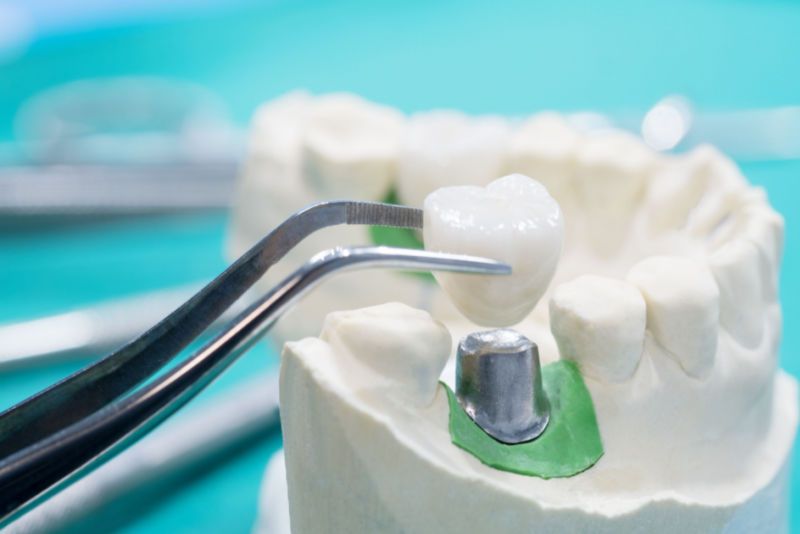Insightful and informative dentist blog, covering a wide range of dental topics alongside new treatment & clinic announcements.

Dental Crowns Procedure
Dental crowns are part of our general dentistry service. A dental crown is a porcelain (or gold) replica of a tooth, and it is used to restore a tooth that has been damaged or weakened by decay. It is fixed to the tooth’s root, or if you have lost the tooth completely, the crown can be attached to the surrounding teeth either side of the gap in order to form a bridge. Read more about the dental crown procedure for both permanent crowns and temporary crowns below.
Types of dental crowns
Dental crowns can be made up of different filling materials, depending on the type of crown required. These include:
- All ceramic or all porcelain crowns: Typically these types of dental crowns are the best option for replicating the color of your natural teeth. However, they can also be more prone to wearing down the teeth opposite, more so than metal or resin crowns.
- Resin crowns: Generally, these dental crowns are the cheapest, however, they are often more severely worn or chipped down and are likely to need a replacement over time.
- Metal crowns: A number of different metals can be used in dental crowns, whether it’s gold, nickel, or palladium. Metal crowns rarely chip or break and tend to be more durable and hard-wearing than other dental crowns.
- Porcelain fused to metal: This type of dental crown has a more natural tooth colour. Porcelain fused to metal crowns are ideal for front or back teeth crown placement
- Zirconia crowns: These dental crowns are normally used when people have severely worn down teeth or have teeth missing. They offer greater strength and durability than many other crown types.
How much do crowns cost in the UK?
The cost of dental crowns varies, and the exact price will depend on the type of dental crown and the filling material used. Front teeth crowns usually cost slightly more than out-of-sight molars.
Pricing of dental crowns will ultimately be determined by what type of crown you choose. Metal crowns will tend to be less expensive than the porcelain fused to metal crown, for example. Similarly, an all-porcelain crown on your front tooth will likely be cheaper than an all-ceramic crown for a broken tooth located at the back of your mouth.
For some patients, root canal treatment may be necessary before the crown impressions can be made, this will take longer than fixing a traditional or loose crown. If your crown feels loose, call your dentist’s office, or simply visit your dentist to disucss the next steps.
Before your permanent dental crown is fitted
After an initial consultation, you will need two visits to the clinic – the first to take an impression of your teeth, as well as fit the temporary crown, and the second to fit the permanent crown. On your first visit, we will take an impression of your teeth. This will be sent to a dental laboratory where your permanent crown will be created, enabling technicians to produce a precise replica of the natural tooth. We will also determine the shade of your teeth to ensure the crown is the right colour – this is especially important if your crown is being fitted on a front tooth. NB this is not necessary if you’ve chosen to have a gold crown.
Fitting a temporary crown
Fitting the temporary crown will involve a local anesthetic. First, we’ll need to prepare the tooth so it is the ideal shape for the crown. We will then take an impression of the tooth and the surrounding teeth on either side of it which we’ll use to make a temporary crown in the clinic while the permanent one is being made.
and remove parts of the natural damaged tooth and any fillings in order to create an abutment on which to attach the crown. If we discover any tooth decay, we will deal with it at this stage. As soon as the tooth abutment is shaped, we will fix the temporary crown. This is vital to protect your tooth – a lot of enamel is removed in the reshaping process, and without the protection of a crown, this would result in your underlying tooth becoming highly sensitive to both temperature and pressure.
Fixing the permanent crown
As soon as we have received your permanent crown from the laboratory, you can come to the dentist’s office immediately for the final fitting. This will be done under local anaesthetic. We will remove the temporary crown and make sure the tooth is completely dry. Any minor adjustments will be made there and then, but in the rare eventuality that the crown doesn’t fit perfectly, it may have to be returned to the laboratory and a new crown will be made. As soon as we’re happy with the fit, the newly crowned tooth will be bonded onto the tooth with dental cement and checked to make sure it fits OK in relation to your tooth structure or opposing tooth.
After your permanent dental crown is fitted
You need to be more careful with what you eat as foods such as nuts and boiled sweets could cause damage. You must continue (or create) a good oral hygiene routine that includes regular brushing and flossing as well as check-ups and hygienist appointments. If you damage the crown in any way, make an appointment with us straight away so we can make any necessary repairs. although metal crowns rarely chip, look after your crown to protect it from gum disease and decay, and it will be effective for many years to come.
If you would like to talk to us about dental crowns, general dentistry or cosmetic dentistry, please don’t hesitate to get in touch or book a free consultation.